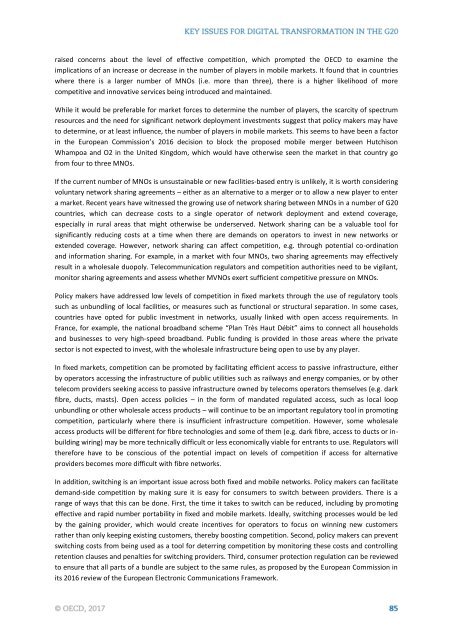KEY ISSUES FOR DIGITAL TRANSFORMATION IN THE G20
2jz0oUm
2jz0oUm
You also want an ePaper? Increase the reach of your titles
YUMPU automatically turns print PDFs into web optimized ePapers that Google loves.
aised concerns about the level of effective competition, which prompted the OECD to examine the<br />
implications of an increase or decrease in the number of players in mobile markets. It found that in countries<br />
where there is a larger number of MNOs (i.e. more than three), there is a higher likelihood of more<br />
competitive and innovative services being introduced and maintained.<br />
While it would be preferable for market forces to determine the number of players, the scarcity of spectrum<br />
resources and the need for significant network deployment investments suggest that policy makers may have<br />
to determine, or at least influence, the number of players in mobile markets. This seems to have been a factor<br />
in the European Commission’s 2016 decision to block the proposed mobile merger between Hutchison<br />
Whampoa and O2 in the United Kingdom, which would have otherwise seen the market in that country go<br />
from four to three MNOs.<br />
If the current number of MNOs is unsustainable or new facilities-based entry is unlikely, it is worth considering<br />
voluntary network sharing agreements – either as an alternative to a merger or to allow a new player to enter<br />
a market. Recent years have witnessed the growing use of network sharing between MNOs in a number of <strong>G20</strong><br />
countries, which can decrease costs to a single operator of network deployment and extend coverage,<br />
especially in rural areas that might otherwise be underserved. Network sharing can be a valuable tool for<br />
significantly reducing costs at a time when there are demands on operators to invest in new networks or<br />
extended coverage. However, network sharing can affect competition, e.g. through potential co-ordination<br />
and information sharing. For example, in a market with four MNOs, two sharing agreements may effectively<br />
result in a wholesale duopoly. Telecommunication regulators and competition authorities need to be vigilant,<br />
monitor sharing agreements and assess whether MVNOs exert sufficient competitive pressure on MNOs.<br />
Policy makers have addressed low levels of competition in fixed markets through the use of regulatory tools<br />
such as unbundling of local facilities, or measures such as functional or structural separation. In some cases,<br />
countries have opted for public investment in networks, usually linked with open access requirements. In<br />
France, for example, the national broadband scheme “Plan Très Haut Débit” aims to connect all households<br />
and businesses to very high-speed broadband. Public funding is provided in those areas where the private<br />
sector is not expected to invest, with the wholesale infrastructure being open to use by any player.<br />
In fixed markets, competition can be promoted by facilitating efficient access to passive infrastructure, either<br />
by operators accessing the infrastructure of public utilities such as railways and energy companies, or by other<br />
telecom providers seeking access to passive infrastructure owned by telecoms operators themselves (e.g. dark<br />
fibre, ducts, masts). Open access policies – in the form of mandated regulated access, such as local loop<br />
unbundling or other wholesale access products – will continue to be an important regulatory tool in promoting<br />
competition, particularly where there is insufficient infrastructure competition. However, some wholesale<br />
access products will be different for fibre technologies and some of them (e.g. dark fibre, access to ducts or inbuilding<br />
wiring) may be more technically difficult or less economically viable for entrants to use. Regulators will<br />
therefore have to be conscious of the potential impact on levels of competition if access for alternative<br />
providers becomes more difficult with fibre networks.<br />
In addition, switching is an important issue across both fixed and mobile networks. Policy makers can facilitate<br />
demand-side competition by making sure it is easy for consumers to switch between providers. There is a<br />
range of ways that this can be done. First, the time it takes to switch can be reduced, including by promoting<br />
effective and rapid number portability in fixed and mobile markets. Ideally, switching processes would be led<br />
by the gaining provider, which would create incentives for operators to focus on winning new customers<br />
rather than only keeping existing customers, thereby boosting competition. Second, policy makers can prevent<br />
switching costs from being used as a tool for deterring competition by monitoring these costs and controlling<br />
retention clauses and penalties for switching providers. Third, consumer protection regulation can be reviewed<br />
to ensure that all parts of a bundle are subject to the same rules, as proposed by the European Commission in<br />
its 2016 review of the European Electronic Communications Framework.


